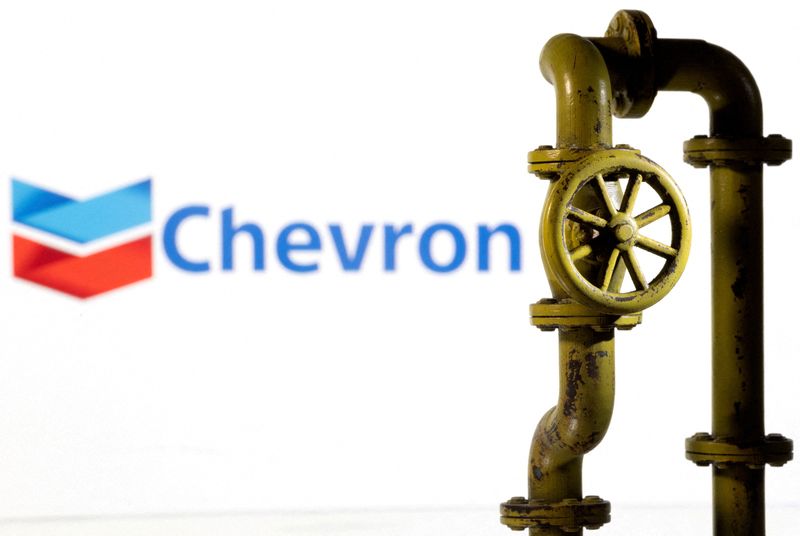(Reuters) - Workers at Chevron (NYSE:CVX)'s two major Australian liquefied natural gas (LNG) projects voted to restart strikes accusing the U.S. energy major on reneging its prior commitments.
Australia's Offshore Alliance union had called off strikes at Chevron's facilities after the union and Chevron accepted proposals from the country's industrial arbitrator, resolving a fight that threatened to disrupt around 7% of the world's LNG supply.
Chevron had been negotiating with the workers for months at the same as Australia's Woodside (OTC:WOPEY) Energy, which managed to avert strikes in August after reaching a deal.
Here is a sequence of events leading up to the strike action:
Date Development
Aug. 9 Workers at Woodside's liquefied LNG
facilities in Australia vote for industrial
action.
Aug. 10 Chevron and Woodside say they are holding
talks with union to avert any potential
action by the workers.
Aug. 11 Australia's labor regulator, the Fair Work
Commission, allows workers' union to hold a
ballot of employees to decide if they wanted
to make a decision on taking industrial
action at Chevron's Gorgon and downstream
Wheatstone LNG facilities.
Aug. 15 Negotiations between Chevron, Woodside Energy
Group and Australian unions continue but a
source with knowledge of the matter tells
Reuters that the talks are unlikely to yield
results for days.
Aug. 16 Woodside says "positive progress" was being
made on talks with a union alliance on
disputes over the wages of workers.
Aug. 16 The Offshore Alliance says during the
negotiations Woodside was "well off the pace
on key bargaining issues including job
security and remuneration."
Aug. 18 Voting opens in Chevron's
facilities to let workers decide if they want
to strike due to disputes over wages and
working conditions.
Aug. 20 Unions at Woodside's North West Shelf
offshore gas platforms announce plans to
strike as early as Sept. 2.
Aug. 22 Woodside CEO Meg O'Neil says the company has
had "constructively addressed" several
concerns of workers but said it also has a
duty to shareholders to be able to run the
business.
Aug. 23 Woodside and unions meet for another round of
talks to avoid the strikes.
Aug. 23 Chevron's Australian unit says it would
increase domestic gas production capacity at
its Wheatstone facility.
Aug. 24 Woodside reaches an in-principle agreement
with unions to avert strikes.
Aug. 24 Workers at Chevron's Gorgon and Wheatstone
downstream facilities vote to allow unions to
call for a strike if necessary.
Aug. 25 Unions at Chevron's LNG facilities in
Australia warn that work stoppages could cost
the U.S. energy major billions in exports if
workers' demands on wages and conditions were
not met.
Aug. 28 Workers at Chevron's offshore Wheatstone
facility grant unions the power to call
strikes on their behalf.
Aug. 28 Unions representing workers at Chevron's two
major Australian LNG complexes say that they
will take industrial action from Sept. 7.
Aug. 29 Chevron's workers release details of
industrial action including potential work
stoppages of up to 10 hours.
Sept. 1 Chevron workers reject a company pay and
conditions offer.
Sept. 1 The offshore alliance says no meetings have
been scheduled between unions and Chevron.
Sept. 4 Mediation talks to avert strikes at Chevron's
LNG facilities in Australia begin once again.
Sept. 5 Chevron workers announce plans for total
strikes from Sept. 14 if their demands were
not met.
Sept. 5 Some employees of Chevron's Wheatstone LNG
facility in Australia offer to work during
industrial action in a bid to avert domestic
supply disruptions, the Offshore alliance
says.
Sept. 6 Workers at Chevron's LNG facilities agree to
pause planned strike action for one day until
Sept. 8.
Sept. 7 Chevron's LNG workers agree to delay the
strike until 1 p.m. local time in Perth (0500
GMT) on Sept. 8 from the earlier scheduled
start at 6 a.m. in Perth.
Sept. 8 Workers at Chevron's LNG project begin strike
as talks between the company and the unions
fail to yield any results.
Sept. 9 Chevron starts withdrawing contractor workers
from Gorgon as the strike continues.
Sept. 11 Chevron says it sees "no reasonable prospect
of agreement" with the workers and would
apply to the Fair Work Commission for an
"intractable bargaining" declaration, which,
if granted, would end the strike and allow
the labor regulator to dictate an agreement.
Sept. 12 The office of the labor regulator said it
would hold a hearing on Sept. 22 about the
dispute, while the unions wanted it to be
held at a later date in November.
Sept. 14 Union group Offshore Alliance said a turbine
tripped at one of Wheatstone's two LNG
trains, which convert natural gas into
liquid, on the same day strikes escalated.
Sept. 15 Workers begin a 24-hour strike at Chevron's
LNG plants. Union representative says they
intend to extend industrial action for a
further two weeks to mid-October.
Sept. 18 Chevron says full production had resumed on
Sept. 17 at its Wheatstone LNG plant after a
fault last week cut production by almost a
quarter.
Sept. 20 Latest round of talks between Chevron and
unions at its two LNG facilities in Western
Australia ends without a deal.
Sept. 21 Chevron says it would accept the terms of a
deal brokered by the Fair Work Commission to
end the dispute.
Sept. 22 Australian union alliance calls off strikes
at Chevron's two major LNG projects after
accepting proposals from the country's
industrial arbitrator to end long-running
disputes over pay and conditions.

Oct. 5 Workers vote to restart strikes accusing
Chevron of reneging on commitments.